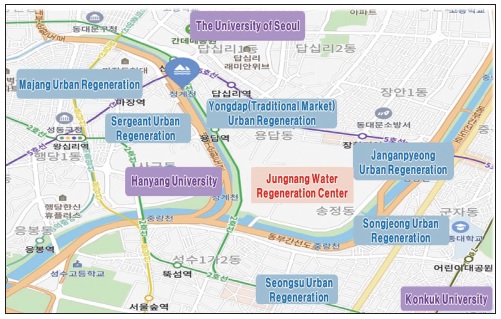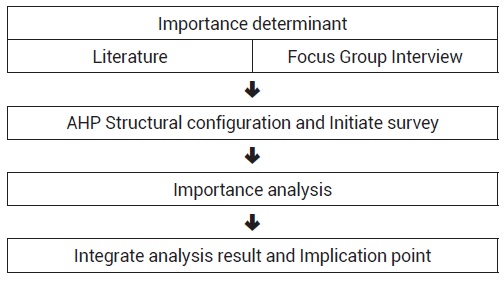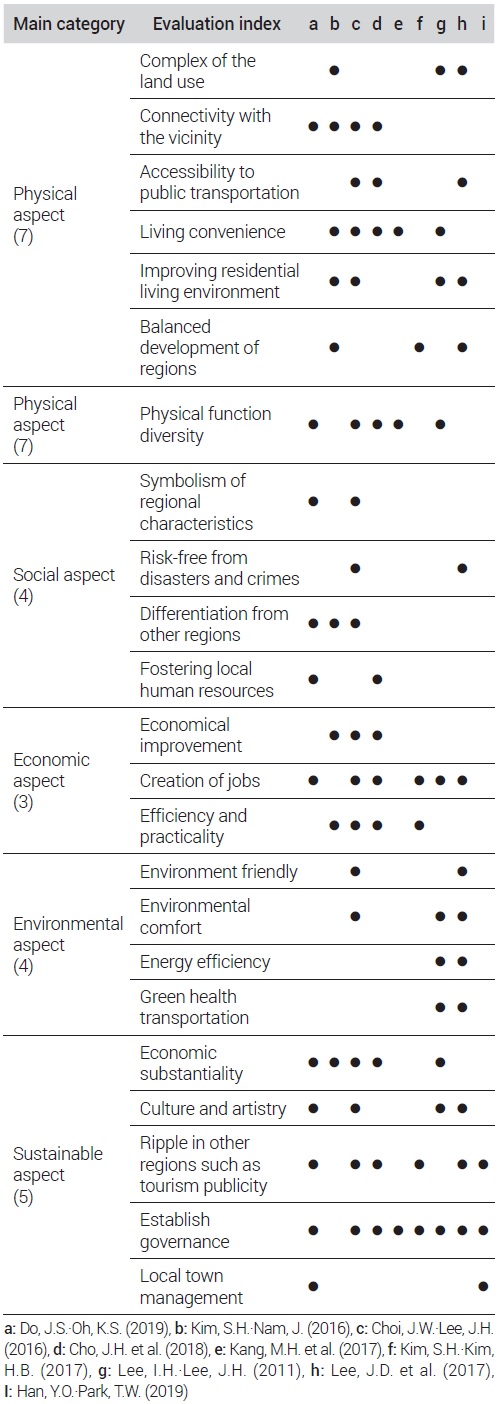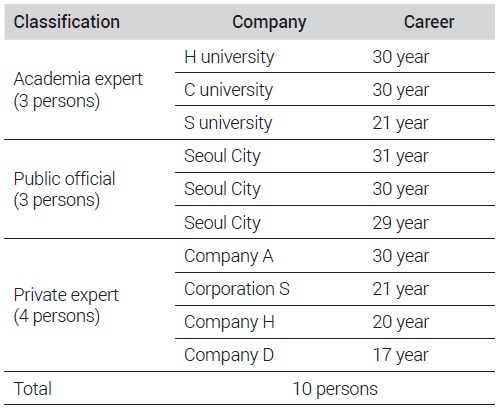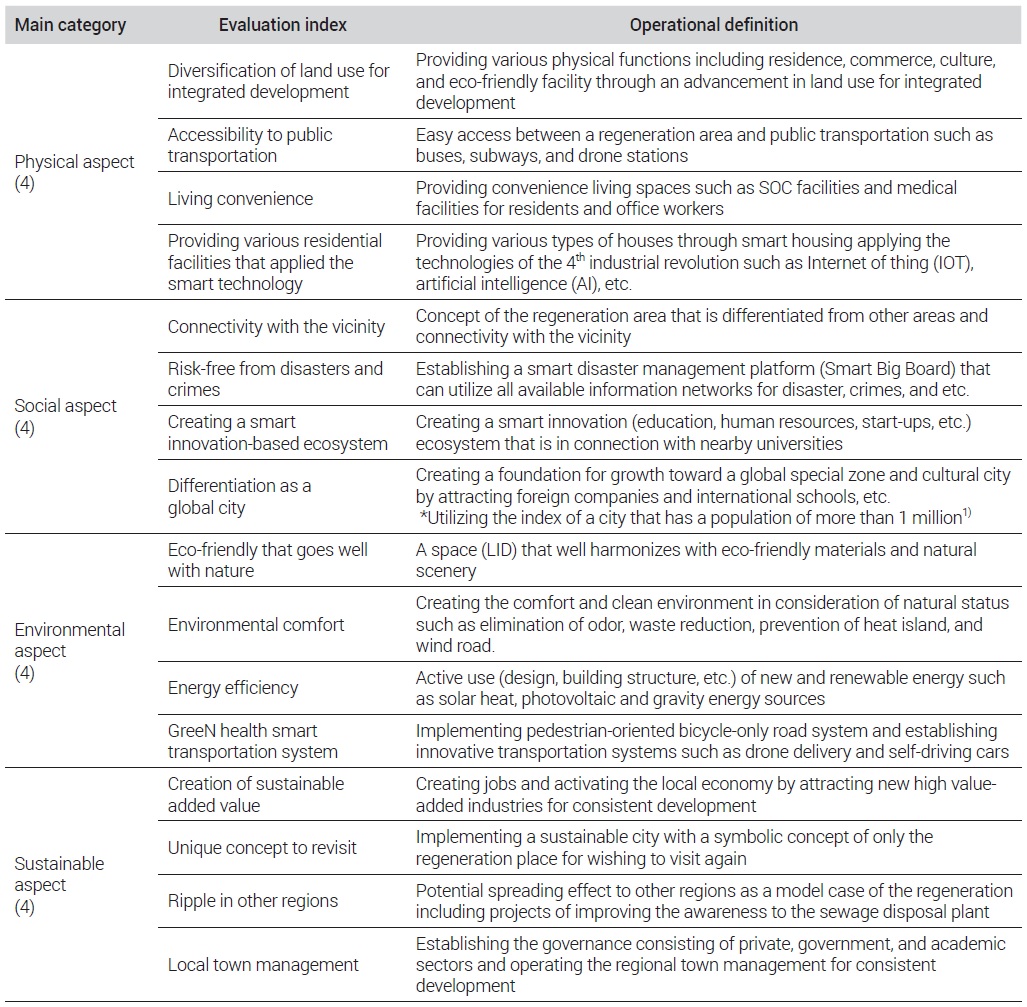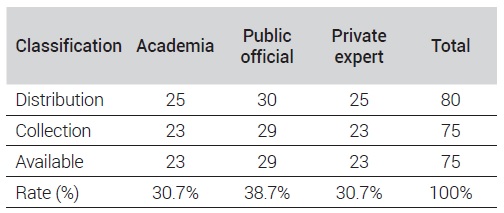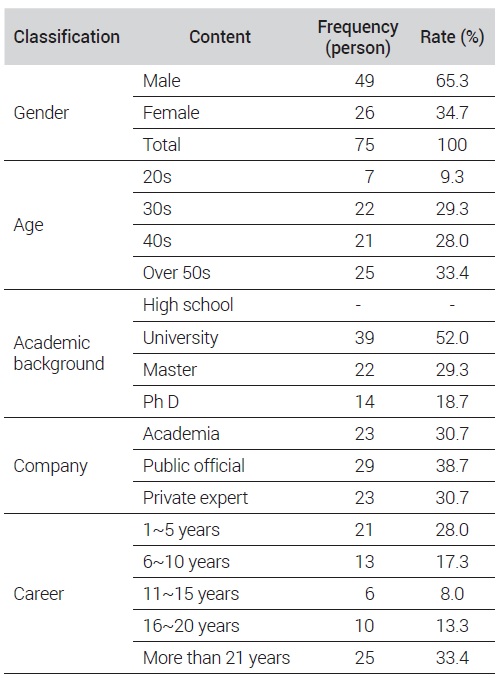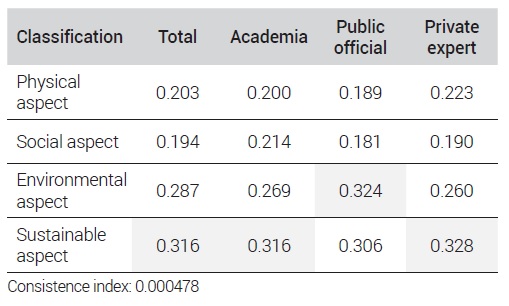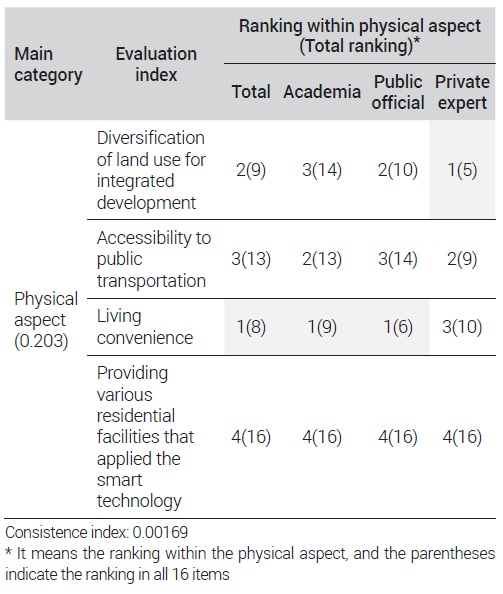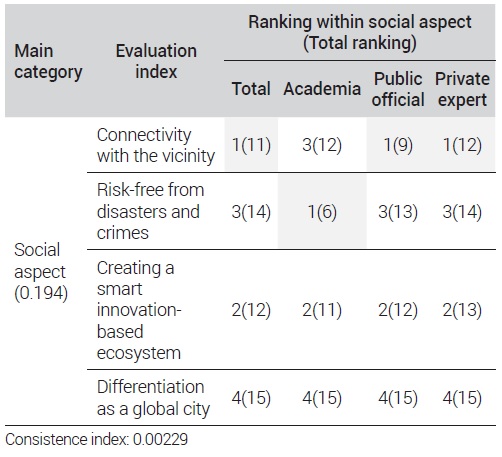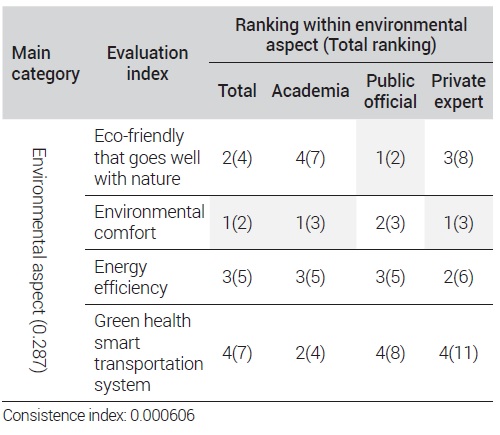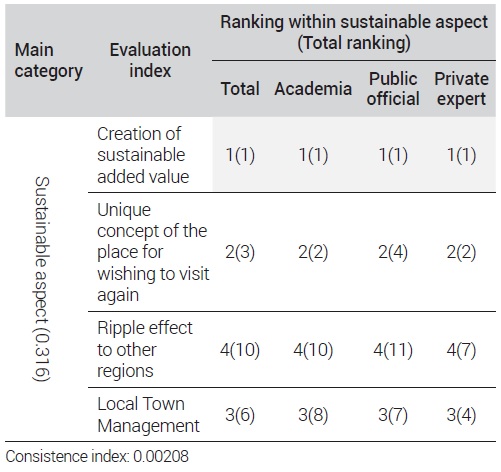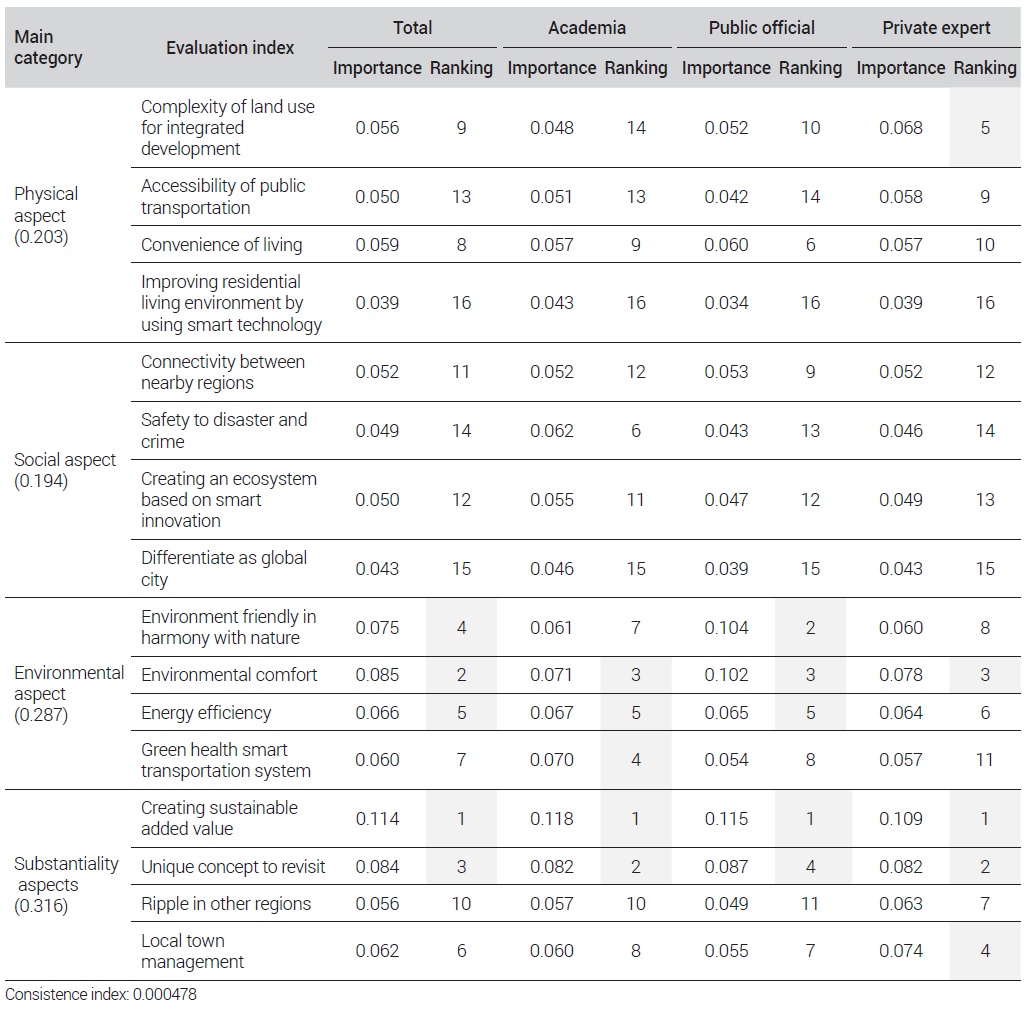
Final publication date 16 Nov 2021
Analysis on Priority and Importance of Regeneration of Idle Land: Case Study on an Obsolete Sewage Treatment Plant
Abstract
To establish a sustainable city, unpleasant facilities such as a sewage treatment plant should be modernized. In this regard, this study aims to analyze the important factors that should be reviewed in advance when regenerating a large-scale idle land like a sewage disposal plant. Regarding the important factors, a survey was conducted after selecting four main domains and 16 sub-domains through a precedent study and the focus group interview (FGI: interview by an expert group).
As a result of analysis employing the AHP technique, the main domains showed 0.315 at sustainable aspect, 0.287 at environmental aspect, 0.203 at physical aspect, and 0.194 at social aspect. In the sub-domains, the highest score was a creation of added value that should be the first considered in priority, followed by an environmental comfort and a unique concept of the place for wishing to visit again as the second and third, respectively.
The results of this study can be utilized as fundamental data for important factors to be considered when regenerating the idle lands according to the modernization of sewage disposal plants nationwide in the future. Moreover, it has implications for providing a professional perspective that considers not only the regeneration place but also the conditions of the surrounding area.
Keywords:
Sewage Treatment Plant, Modernization (Integration), FGI, AHP Technique, Urban Regeneration키워드:
하수처리시설, 현대화(집적화), FGI, AHP 기법, 도시재생Ⅰ. Introduction
1. Research Background and Objective
Environmental infrastructure facilities are necessary for the maintenance of the city environment, but local residents consider such facilities to be unpleasant due to their distinctive characteristics. These facilities can be categorized into facilities related to sewage and waste water, such as wastewater treatment facilities, sewage treatment facilities, livestock and excrement treatment facilities, and facilities related to waste, such as landfills and incineration facilities. These environmental infrastructure facilities are initially constructed away from residential areas, but as the city expands, the distance between the residential areas and these facilities decrease, resulting in a constant flow of complaints from nearby residents about odor, noise, and unsanitary conditions. This has led to the Not In My Back Yard (NIMBY) phenomenon which can cause conflict and dispute between regions or with local governments due to negative perceptions of the residential environment and unsatisfactory environments in comparison to other regions (Bong-soo Choi et al., 2014).
Currently there are 4,216 sewage treatment plants in Korea starting with the first Cheonggye Sewage Treatment Plant in 1976 (Jungnang Water Regeneration Center today). Looking at the chronological changes in the sewage treatment plant policy, prior to the 1980s, the focus was on sewer pipeline planning to prevent flooding as urbanization progressed due to rapid industrial expansion. From 1980 to before the 2000s, the focus was on the construction of public sewage treatment facilities for water quality improvement. Since the 2000s, policies to improve river water quality have been implemented by separating rainwater facilities and modernizing sewage treatment facilities. As of 2018, there were a total of 665 treatment facilities that can treat more than 500 m3 daily. 179 facilities are less than 10 years old, 327 facilities are less than 20 years old, 94 facilities are between 20~24 years old, 47 facilities are between 25~29 years old, and 18 facilities are 30 years old or older. Among these, facilities that are 25 years old or older are mostly large scale sewage treatment plans and are in the process of deteriorating. In particular, among the 18 facilities that are 30 years older or older, 13 of them or 72% are located in the Seoul metropolitan area and 15 facilities have site areas larger than 100,000 m2, so it is predicted that they will become large scale idle lands. Also, the 47 facilities that are 25 years old or older need to be considered since improvement and remodeling projects take 5 years or more (Chang-geum Lee et al., 2019).
Accordingly, modernization is underway for energy independence through the formation of idle land and recycling of organic waste by concentrating existing sites without moving sites and pursuing complete undergroundization centered around aging and obsolete sewage treatment plants. Some facilities have been modernized and provide environmentally friendly and resident friendly facilities, and such facilities include the Anyang New Water Park, Hanam Union Park, and Yongin Suji Respia(Chang-geum Lee et al., 2019).
Modernizing sewage treatment plants that have been perceived as unpleasant facilities and providing facilities for the residents is desirable, but establishing a method of reasonably and effectively utilizing idle land for a sustainable city is also important. Compared to private large-scale sites, public projects can be actively promoted for idle sites on large-scale public land. However, research is lacking on important aspects that should be assessed in advance in the regeneration process of idle land produced from modernization projects. Research is necessary regarding the aspects that need to be considered for the establishment of sustainable cities such as physical aspects and reflection of regional conditions and characteristics for the modernization of facilities and plans to create complexes with various facilities.
The objective of this study was to investigate the important factors that need to be reviewed in advance for the regeneration of idle land on large scale public land from the modernization of sewage treatment facilities and to aid local government set the direction of idle land regeneration.
2. Research Scope and Method
The spatial scope of this study is the Jungnang Water Regeneration Center, which was the first sewage treatment plant in Korea, located in Seongdong-gu, Seoul. The plant is 801,503 m2 in size and has been in operation for 45 years, so deterioration has begun. The waste collection and treatment facilities are scattered nearby, resulting in a consistent flow of complaints in the region. From 2007 to 2018, the stage 1 modernization project was carried out and the world’s largest upcycling cultural complex Seoul Upcycling Plaza was constructed along with the Seoul Sewerage Science Museum on the idle land. Currently, the stage 2 project is under progress at the Jungnang Water Regeneration Center and Seoul Metropolitan City announced the Water Regeneration Center Vision 3.0 in November 2019, which involved the establishment of a cluster for the “water industry” considered a blue ocean in the 21st century at the Jungnang Water Regeneration Center as a new stronghold of future strategic industry cultivation (Seloul Metropolitan Government, 2019).
Stage 1 modernization has been completed and up to stage 3 is planned. The resulting idle land is expected to be approximately 140,000 m2. Urban regeneration revitalization areas are under progress in 6 locations in nearby areas including the largest used car sales center in Korea. The idle land of 140,000m2 can contribute towards the revitalization of the local economy by constructing economic-based urban regeneration facilities and public facilities in conjunction with the used car sales center. Also, this area was selected for this study in that the social perspective can be considered as there are universities located nearby, which provide abundant human resources. <Figure 1> shows a map of the area.
The temporal scope was set from 2007 to 2021 within the Jungnang Water Regeneration Center modernization (2007~2033) project period. Content-wise, this study investigated the importance of urban regeneration from physical, social, environmental, and sustainability perspectives.
The process and method of this study followed these steps. First, the important factors were organized from literature related to idle land regeneration and then the final indices were selected through focus group interview (FGI) with experts. Second, a survey was conducted targeting academic experts, administrative experts, and private development experts, and the analytic hierarchy process (AHP) analysis was performed to analyze the important factors. Lastly, implication points were obtained based on the analysis results. This process is shown in <Figure 2>.
Ⅱ. Theoretical Background and Literature Survey
1. Concept and Types of Idle Land
Idle land can be defined as an area that is not being used and area that is infrequently used. The first case refers to an area that is neglected without any special usage or area that is not being used appropriately because it is larger than needed. The second case refers to an area that has lost its function or area that requires modification of its usage from degradation due to changes in industry structure, paradigm shift in modern society, or population shift from a declining city (Sun-mi Park, 2013; Jae-ryung Shin, Jeong-kyo Lee, 2021). While existing idle land was perceived as having a negative impact, idle land is gradually increasing in value for its potential as a creative and sustainable space that can be transformed with content of regeneration (Ji-wook Choi, Joo-hyung Lee, 2016).
Idle land can be categorized into abandoned, vacant, and underutilized land. Abandoned land is an area that has been developed but is no longer used as intended and temporarily used for a different purpose. Such land includes relocated sites, closed schools, and abandoned houses, and such land is small or mid scale in size. Vacant land is an area that is not developed and not used, includes long-term non-execution facility site and empty plots for construction, and is small or large scale in size. Finally, underutilized land is an area that has been developed and is being used but does not reach the plan density or an area that is more deteriorated than nearby areas. Such land includes low density stagnation areas, deteriorated problematic areas, and obsolete industrial complex areas, and is composed in small and mid scale (Dong-han Kim et al., 2015).
2. Literature Survey
Except for Kim et al.(2015), previous studies on idle land have stated the need to establish a sustainable and effective idle land analysis method and a support system for model development.
Sang-hoon Kim and Jin Nam (2016) stated that the concept of idle land is mixed together with other terminology including industrial heritage and public land, defined idle land as an area with potential and a negative area, and proposed a mixed land use technique corresponding to the characteristics. Joon-geol Oh and Kwang-hyun Kim (2011) claimed that idle land should not be understood as a temporary phenomenon as it is a concept that organically combines idle site and idle facility and should be approached as an urbanization and circulation process. Additionally, the study claimed that it has to be utilized as an element that is effective and recomposes the city prior to the regeneration of the idle land. Hyun-joo Kim and Sang-ho Lee (2011) classified idle land into buildings, industrial facilities, infrastructure, relocated sites, and abandoned sites and stated that the goal of implementing the urban regeneration concept needs to change from simply physical expansion to improvement in quality of life and a space that can sufficiently embody the image and symbolism of the region and carry out the role of economic activation. Also, public-private cooperation organizations and residents, not just one side of the central government and local governments, should be recognized as the actors of regeneration, and that sustainable operation and management measures should be sought together.
Idle land application cases in Korea were investigated in numerous literature. Sang-kyun Lee and Keum-jin Lee (2019) analyzed 10 sites and presented a proposal for stable operation even after the completion of the project so that sustainable operation is possible for a cultural complex space utilizing the idle industrial facility. Jun-seok Do and Kwang-seok Oh (2019) emphasized regional characteristics through the history of the region when applying old industrial facilities by investigating abandoned industrial sites in Korea and analyzed that regional community participation and governance structure are important aspects. So-young Park et al. (2016) considered the publicness, profitability, and efficiency when using idle land for national land and introduced cases where projects are being pursued relatively smoothly when consensus is formed and consultation channels are established between the parties in the public sector.
Hee-jung Yoo et al. (2013) carried out a study of international cases where it was considered that social sustainability can be obtained when shared values in a space, direction towards reason, spatial diachronism, and temporality within history are established in the idle space of modern industrial heritage. Spatial regeneration characteristics were derived by categorization into self-sustained regeneration like the Zona Tortona of Milan and dependent regeneration where external conditions like government policies are applied. Young-hoon Jeon and Dong-chul Shin (2010) introduced 10 international sites that constructed public spaces within industrial heritages through regeneration. Various methods were used to connect with the city through a multi-level open space that induces communication between the city and industrial heritage that was separated through regeneration. Through the junction of daily life, where historical traces of the past and modern life coexist, cases of inducing the participation and interest of local residents, citizens, and the public beyond the reconstruction of spatiality and construction of architectural spaces were introduced. Jin-soo Goh and Jae-young Yang (2015) introduced the Westway Trust Development of the U.K. where unique local resources that cannot be found elsewhere were utilized for application into a creative space by listening to the stories of the local residents. Also, Chul-soon Chang and Seong-chul Cho (2017) introduced the case of Station F in Paris that harnessed urban idle land, cases of connecting urban regeneration with declining areas such as Grand Front Osaka of Osaka, Japan, and Tech City of the U.K., and Applied Science NYC of New York City.
Studies on the analysis of the importance of regeneration were carried out. Jin-wook Choi and Joo-hyung Lee (2016) analyzed the importance of the evaluation indices of idle land from a regeneration perspective using 5 parent items including the physical, economic, social, cultural, and environmental aspects and 17 evaluation indices. Jin-hee Cho et al. (2018) selected 15 items to evaluate the importance for a region leading in the urban regeneration of Changwon City through experts and residents. Maeng-hoon Kang, Hye-seung Song, and Myung-hoon Lee (2017) selected the items of sense of community and promotion organization including physical, non-physical, and resident participation to analyze the differences in satisfaction and importance by categorization into the resident group and expert group for 13 urban regeneration areas pursued by the Seoul Metropolitan City. Sang-hyun Kim and Hyung-bin Kim (2017) categorized the evaluation domain into 16 items from the areas of physical environment, society and culture, industry and economy, and policy and system for the priority order of the urban regeneration project to carry out analysis using each evaluation index. Il-hee Lee and Joo-hyung Lee (2011) selected 5 parent indices including urban environment, transportation, society and culture, economy, resources and energy efficiency for the planning elements in the growth as a sustainable regeneration city and the importance was analyzed. Jeong-dong Lee et al. (2017) derived 23 indices from 54 through 3-stage Delphi analysis to select evaluation indices for the sustained expansion of urban regeneration projects, and lastly presented the major assignment type by organizing similar indices along with 3 experts. Yeon-oh Han and Tae-won Park (2019) carried out analysis of the expert group in order to implement a detailed model of town management related to cooperative planning for the realization of urban regeneration where various parties are participating in. Sang-mi Han and Myung-hoon Lee (2019) investigated the importance related to urban development and management that are sustainable and resilient for 11 SDG targets and indices were selected for each sub-category so that they can be used as practical evaluation indices.
The originality of this study over the previous studies and literature is as follows.
First, most of the studies on sewage treatment plants that have been carried out were concerned with improvements to the sewage treatment process. Research on the regeneration of idle land through the modernization of sewage treatment plants is almost nonexistent except for a study on the effects of the satisfaction towards a park formed using idle land on the local community. This study is expected to be useful basic reference material in the future regeneration of sewage treatment facilities.
Second, existing literature only considered the regeneration area itself but this study considers the regeneration area as well as quantitatively analyzing the major factors that determine the distinct characteristics of the surrounding region, connection with the nearby universities that provide education and abundance human resources, and uniqueness as a global city.
Third, previous studies on the regeneration of idle land were analyzed from a consequential perspective including analysis of the application of the idle land and factors that affect sustainability with regard to cases where idle land regeneration has been completed, but this study analyzed the important indices that need to be considered prior to the regeneration of idle land. In particular, the important analysis methods of this study to be considered during the regeneration of idle land related to the water regeneration center differentiate this study from previous studies as they can be immediately applied by the government and local governments in the future.
Ⅲ. Analysis of Major Factors of Idle Land Regeneration
1. Analysis Flow
For the analysis of important factors during the regeneration of idle land produced from the integration of sewage treatment plants, first, important indices that need to be considered during the regeneration project were to be organized from various perspectives including physical, social, and sustainability points of view, breaking beyond the conventional regeneration project that only focuses on transforming the land into parks and considers only the environmental perspective based on previous studies and expert interviews. Especially, in order to overcome the limitation of focusing only on conventional regeneration areas, the social aspect that takes into account the connectivity with the area nearby the regeneration was considered and important indices were to be reflected so that a sustainable city can be formed after the completion of the regeneration. Based on this target direction, 4 main categories and 16 evaluation indices were selected.
Second, based on the final item selection, the AHP technique structure was configured for the relative pairwise comparison between the important factors and a survey was carried out regarding the important factors to related academia, public officials and experts.
Third, the survey result was analyzed to propose policy regarding the importance of the 4 main categories and 16 evaluation indices that need to be considered for the regeneration of large scale idle public land.
2. Selection of Analysis Index for Important Factors of AHP
The primary index was those selected by at least 2 researchers from literature where the indices that need to be considered for a regeneration project due to modernization are 5 main categories and 23 evaluation indices as shown in <Table 1> in detail.
The “physical aspect” refers to improving the physical characteristics of the regeneration area to maximize the utilization of the space and increasing convenience for the residents. In this study, the following 7 factors for the physical aspect were selected: complex of the land use presented by Sang-hoon Kim and Jin Nam (2016), connectivity within the vicinity, comprehensive accessibility to public transportation presented by Jeong-dong Lee et al. (2017), residential living environment improvement to provide various residential selection opportunities presented by Il-hee Lee and Joo-hyung Lee (2011), pursuit of the balanced development of regions to resolve the differences between regions from changes in the physical environment presented by Sang-hyun Kim and Hyung-bin Kim (2017), and pursuit of physical diversity for the activation of the local economy and the lives of residents as well as improving the physical characteristics presented by Jin-wook Choi and Joo-hyung Lee (2016).
The “social aspect” refers to the symbolic significance of the regeneration area and the connection of an inadequate space turned into a safe and special space with the nearby areas. In the study by Jin-wook Choi and Joo-hyung Lee(2016), regeneration in the social perspective has to hold symbolism that embodies the unique characteristics of the region and derived uniqueness that differentiates the area from other regions and safety of the deteriorated space. Jin-hee Cho et al. (2017) used 4 factors as indices including the regional manpower and human talent cultivation. In this study, the indices of these previous studies were adopted.
The “economic aspect” refers to bringing about economic change by supporting practicality with economic value and creation of jobs. Jin-wook Choi and Joo-hyung Lee (2016) and Jin-hee Cho et al. (2018) derived 3 factors including local economy revitalization through economic feasibility and job creation that produced economic value and efficiency that considers the effects on the local residents relative to the investment cost, and practicality.
The “environmental aspect” refers to the environmental improvements made considering the unique characteristics of the sewage treatment plant. Jeong-dong Lee et al.(2017), Il-hee Lee and Joo-hyung Lee (2011), and Jin-wook Choi and Joo-hyung Lee (2016) used environment friendliness that blends in with the regional natural environment through the cultivation of greenery and waterfront areas, creation of a pleasant and clean environment through waste reprocessing and waste reduction, energy efficiency that actively pursues natural energy sources like solar energy, and green health transportation including the establishment of pedestrian oriented bicycle lanes as factors for the environmental aspect.
Finally, the “sustainable aspect” refers to the factors that provides sustainability and autonomy after the beginning and completion of the regeneration project. The 5 factors of maintenance of sustainability in economic terms through the creation of added value selected by Joon-seok Doh and Kwang-seok Oh (2019), production of culture and artistry and cultural resources as a region to be rediscovered culturally selected by Jin-wook Choi and Joo-hyung Lee(2016) and Sang-hyun Kim and Hyung-bing Kim(2017), propagation to other regions and establishment of regional governance for sustainable development including tourism, promotional activities, and awareness raising education program as non-physical regeneration project factors selected by Maeng-hoon Kang et al. (2017), and establishment and operation of autonomous local town management selected by Yeong-oh Han and Tae-won Park (2019) were used as the indices for the sustainable aspect.
Expert interviews were conducted for the 5 main categories and 23 items selected from previous studies. A total of 10 people were selected including 3 academic experts on urban regeneration, 3 related public officials, and 4 experts on private development, and interviews were carried out by visiting them in person or over the phone. <Table 2> shows the FGI target group.
Interviews were carried out over 2 sessions: the first session was from February 1 to February 10, 2021, and the second session was from February 15 to February 19. Comments were collected through the interviews and the selected indices from the previous studies in the first session along with aspects that need to be additionally considered, and the verification was conducted in the second session.
The overall comments from the first session regarding the “physical aspect” was that connectivity with nearby areas is a concept that contains both the hardware and software sides so it should be modified to the social aspect category and the residential environment improvement index should be modified to the provision of various residential facilities utilizing smart technologies considering the distinct characteristics of the regeneration area where a residential area has not been established. Also, comments were made to integrate the diversity of physical function with the complex and delete the balanced development to resolve differences between regions from the index as the alleviation of the disparity between regions occurs naturally from the environmental improvement.
For the “social aspect”, there were comments to add the concept of the project to the operational definition for increased clarity in order to show the symbolism representing the regional characteristics along with detailed comments on implementing the concept of smart cities into the social aspect. For example, there were comments to add establishment of a smart city to create a space safe from natural disasters and crime, fostering local manpower, education connecting regional universities for the cultivation of a smart innovation based ecosystem, and utilization of human resources.
The main category of “economic aspect” was similar with the “sustainable aspect”, there were comments for the integration of the economic improvement and job creation indices into the creation of sustainable added value, the addition of the culture and artistry index to include the unique regional concept, and integration of the establishment of governance and local town management.
FGI was carried out with regard to the indices organized after the primary collection of comments, and the received comments showed that the indices were appropriate.
For the primary 23 indices selected, a secondary interview (FGI) was conducted with 10 experts where the 16 indices that received approving comments from all the experts were selected as the final indices. As shown in <Table 3>, the final selection involved the 4 main categories of physical, social, environmental, and sustainable aspects and 16 evaluation indices.
For the “physical aspect”, a total of 4 indices were selected for the maximization of space utilization by improving the physical characteristics and increasing convenience for the residents including residence. This includes the provision of the complex of land usage and living SOC facilities, medical facilities, residential facilities incorporating Fourth Industrial Revolution technologies in order to provide various physical functionality in addition to resident friendly spaces such as parks for increased convenience for residents. Additionally, accessibility to mass transportation is to be enhanced for convenient use of such physical aspects. For the “social aspect”, a total of 4 indices were selected for the cultivation of a differentiated space considering the connected aspect with the nearby regions and the transformation of an inadequate space into a safe space. This includes the connectivity with other regions, the unique concept of the regeneration area in terms of culture, arts, and history, safety from natural disasters and crime, cultivation of a smart innovation ecosystem that connects with the nearby universities that provide abundant human resources, and distinctive characteristics as a global city based on these attributes. For the “environmental aspect”, a total of 4 evaluation indices were selected including environmental comfort such as reduction of odor that has become a major problem of the sewage treatment plan as an index for the environmental improvement considering the properties of the facility, environment friendly that blends in with nature, the efficiency of renewable energy sources such as solar energy and gravitational energy, and the establishment of an innovative transportation system. For the “sustainable aspect”, elements for the sustainability and autonomy during and after the regeneration project were selected. A total of 4 evaluation indices were selected: job creation and local economy revitalization through the attraction of new high value added industries for sustainable development, consideration of the concept of a regeneration area that people want to visit again, propagation to other regions as an exemplary case such as a sewage treatment facility awareness improvement project, and the operation of local town management for continuous operation after the completion of the regeneration.
Ⅳ. Importance Evaluation Analysis on Idle Land Regeneration
1. Survey and Data Collection
A survey was created using the final indices selected based on the expert interview results. 80 surveys were distributed to university professors, researchers, academic experts in fields related to urban development and regeneration, public officials handling related tasks at the Seoul Metropolitan City and Seongdong-gu, and private development experts during the period of 2021. 4. 12. ~ 4. 30 (4 weeks). A total of 75 responses or 93.8% were collected all with valid responses as shown in <Table 4>.
Looking at the demographics of the survey respondents, there were more male respondents than female with 49 male respondents or 65.3% and 26 female respondents or 34.7%. 7 respondents were in their 20s, 22 respondents were in their 30s, 21 respondents were in their 40s, and 25 respondents were 50 years old or older, which was the most populated group. The final education of the respondents was university undergraduate for 39 respondents or 52.0%, master’s for 22 respondents or 29.3%, and doctorate for 14 respondents or 18.7%. With regard to the occupation of the respondents, they were categorized into academia, public officials, and private developers. As shown in <Table 5>, 21 respondents or 28.0% worked for less than 5 years, 13 respondents worked between 6~10 years, 6 respondents worked between 11~15 years, 10 respondents worked between 16~20 years, and 25 respondents worked for 21 years or more, which was the most populated group.
2. Index Importance Analysis Results through AHP
The total value of the consistency index (CI) of the AHP model was 0.000478, which is below the value of 0.10 for confidence in consistency, showing reasonable consistency. All the CI values for the main categories and evaluation indices were all reliable and the CI values were shown on the bottom of the analysis table for each item.
<Table 6> shows the overall importance order of the main categories obtained from the pairwise comparison result of the important item main categories of “physical aspect”, “social aspect”, “environmental aspect”, and “sustainable aspect” for the regeneration of idle land in national and public land due to the modernization (integration) of sewage treatment plants. Survey results evaluated the main categories in the order of sustainable aspect with 0.316, environmental aspect with 0.287, physical aspect with 0.203, and social aspect with 0.194. This result suggests that job creation and local economy revitalization should be pursued as the most important project through by attracting high value added new industries for sustainable development through modernization rather than the environmental aspect of the sewage treatment plant. However, the public official survey respondents selected the environmental aspect as the more important factor over the sustainable aspect.
Comprehensive analysis of the relative importance of the “physical aspect” main category of the important items for the regeneration of idle land within national and public land due to the modernization (integration) of the sewage treatment plant revealed that the importance of convenience in life was evaluated most highly followed by the complex of land use for integrated development, accessibility to public transportation, and provision of various residential facilities applying smart technology. Especially, academia and public official survey respondents selected the physical aspect for convenient living of residents, regional visitors, and business workers as the most important factor while private experts evaluated the complex of land use for integrated development as the most important factor, which was considered a result that reflects profit-making being the goal of private development. The details of the result is shown in <Table 7>.
Evaluation of the important factor in the social aspect revealed that the connection between the regeneration area and the nearby areas was selected as the most important factor. This result showed the importance of the connection with the nearby areas and the concept of the regeneration area that is unique from other regions such as local culture, art, and history as transportation between cities and regions has become easy in modern society through advancements in transportation. However, academia selected safety from natural disasters and crime as the most important factor while ecosystem cultivation based on smart innovation was selected as the second most important factor by all the survey respondent groups. The overall ranking put safety from natural disasters and crime in third place followed by differentiation as a global city as shown in detail in <Table 8>.
The first and second place indices in the social aspect not only considered the regeneration area but also presented a direction of developing together in connection with the local region, universities, and special urban planning aspects. For example, after the decline of the steel industry, the city of Pittsburgh created an IT and life science cluster based on the top notch human resources of Carnegie Mellon University, which is centered on engineering. Similarly, there are 6 regeneration areas nearby including Janganpyeong, Songjeong, and the Seongsu area near the Jungnang Water Regeneration Center that includes Majang, Sageun, Yongdap, and the car sales center along with Hanyang University, Konkuk University, and the University of Seoul, thus, establishing a connection with these areas and the regeneration area will be of importance.
Evaluation of the important factors of the environmental aspect revealed that the cultivation of a clean and pleasant environment is the most important factor for the regeneration area, which has been considered an unpleasant facility due to the smell of the sewage treatment plant. Following this in order of importance was environment friendly blending in with nature, energy efficiency applying renewable energy, and green health smart transportation system. This result showed that solving the most chronic problem of the sewage treatment plant, odor reduction, is the most important consideration from an environmental point of view for the facility that has been shunned and avoided. The detailed results are shown in <Table 9>.
Evaluation of the important factor for the sustainable aspect revealed that sustainable creation of added value was first place followed by a unique concept of the area that people want to revisit, local town management, and propagation to other regions. <Table 10> shows the detailed results.
The first and second places in the sustainable aspect also ranked high in the overall ranking, showing the consideration and direction of future income from sustainable creation of high added value in addition to the improvement of the environment through the regeneration project. This suggests that from a social point of view, it is important to find a concept that can create added value based on connectivity with neighboring areas and a smart innovation ecosystem. For example, this can be considered to be in a similar context with the restoration project of the Cheonggye stream that achieved a massive revolution in the urban paradigm under the large concept of natural environment restoration. Also, Seoul changed the Janganpyeong area urban regeneration plan, which includes the Jungnang Water Regeneration Center and the car sales center, in the 2025 Seoul Regeneration Strategic Plan announced in 2018 from “downtown development” to “economy based development” for the cultivation of the future automobile strategic industry (Seloul Metropolitan Government, 2018). This can be considered the result of the importance of forming a sustainable city by identifying factors such as the creation of high value added new industrial complexes that can create added value in the regeneration area and neighboring areas.
3. Overall Analysis Results
Factors in the order of importance that need to be considered overall for the regeneration of idle land were “creation of sustainable added value”, “environmental comfort”, “unique concept of the area to want to visit again”, “environment friendly that goes well with nature”, and “energy efficiency”. This result emphasizes the importance of establishing a sustainable city by finding a concept that is unique from other regions and creating added value in addition to the important aspect of improving the environment of the sewage treatment plant, which has been perceived as an unpleasant facility. The local town management index was selected as the 6th place in the importance ranking and this is considered important even after the completion of the project to maintaining the sustainability of the city. <Table 11> shows the results of the importance analysis.
In the case of academia, the indices were ranked in the order of importance starting with the creation of sustainable added value, unique concept of the area, environmental comfort, green health smart transportation system, energy efficiency, and safety from natural disasters and crime. Public officials also ranked creation of sustainable added value, environment friendly that goes well with nature, environmental comfort, unique concept, and energy efficiency as listed as the order of importance. This was followed by living convenience and local town management. The connectivity with neighboring areas was selected in 9th place, showing that the social aspect was also considered as an important factor. Private experts ranked creation of added value, unique concept, environmental comfort, local town management as consideration for operation after completion of the project, and complex land use as listed as the order of importance.
Overall, the importance of the sustainable and environmental aspects were analyzed to be high and need to be considered when carrying out future regeneration projects, and while the physical and social aspects are relatively lower ranked in importance, they need to be considered together for the establishment of a sustainable city.
Ⅴ. Conclusion
This study conducted a survey regarding the important factors of 4 main categories and 16 items for large scale idle land produced from modernization of the sewage treatment plant. The survey responses were analyzed and the obtained results were as follows.
First, the order of importance of the main categories that need to be considered for the regeneration of idle land in large scale national and public sites produced from modernization of the sewage treatment plant that has been perceived as an unpleasant facility were the sustainable, environment, physical, and social aspects.
Second, analysis of the relative importance within the sustainable aspect revealed that creation of sustainable high added value was most highly evaluated followed by a unique concept of the area that people want to revisit, local town management, and propagation to other regions. This result suggests that the advancement of the sewage treatment plant, which was considered an unpleasant facility, is expected to expand and grow into a sustainable city.
Third, analysis of the relative importance within the environmental aspect revealed that comfort of the regeneration area through odor reduction of the sewage treatment plant was most highly evaluated as an important factor followed by environment friendly the blends in well with nature, energy efficiency, and green health smart transportation system.
Fourth, analysis of the relative importance within the physical aspect revealed that the importance of living convenience was most highly evaluated followed by complex of land use for integrated development, accessibility to mass transportation, and provision of various residential facilities applying smart technology.
Lastly, analysis of the relative importance within the social aspect revealed that connectivity between the regeneration area and neighboring areas was most highly evaluated followed by smart innovation based ecosystem cultivation, safety from natural disasters and crime, and uniqueness as a global city.
The implications of this paper according to the above analysis results are as follows.
First, this study considered a variety of perspectives including physical, social, and sustainability aspects as well as the environmental aspect for the important factors that can be applied to the sewage treatment plant modernization and regeneration project, thus, the results obtained in this study is expected to be useful basic data when implementing the sewage treatment facility advancement project. Currently there are 15 deteriorating sewage treatment plants in Korea that have been in operation for 30 years or more with site areas of 100,000 m2 or greater and most of these plants are located in metropolitan cities and Gyeonggi-do Province that require modernization project in the near future.
Second, the indices of creation of added value and unique concept of the area that people want to revisit within the sustainable aspect were evaluated to have the highest importance among the 16 indices and this result reveals the need for a broad connection with the regeneration project by considering the surrounding conditions including universities and the distinct characteristics of nearby regions. In the case of the Jungnang Water Regeneration Center, the used car market, automobile repair shops, and part shops, which have established themselves as a Mecca of the car industry in Seoul, are located nearby along with universities that can provide abundant human resources. Utilizing these aspects and cultivating a high value added new industrial complex can have an impact on the revitalization of the local economy. Therefore, this can develop into the strengthening of urban competitiveness and expansion of self-sustaining economic foundation, which are important in urban regeneration.
Third, in order to establish a sustainable city after the completion of the regeneration project, it is necessary to look at the city from a long-term perspective, rather than ending with a simple project, by considering indicators such as town management.
This study has limitations in that the analysis of important factors for consideration before idle land regeneration was conducted for only 1 facility, the Jungnang Water Regeneration Center. As future study, the research scope needs to be expanded to sewage treatment plants nationwide and the characteristics of facilities that can actually undergo regeneration need to be reflected by considering each facility that is deteriorating or has become obsolete.
References
-
Cho, J.H., Kim, Y., Shin, J.W., and Kim, J.T., 2018. “A Study on the Establishment of Evaluation Indicators in Changwon Urban Regeneration Projects”, Journal of The Residential Environment Institute of Korea, 16(4): 123-137.
[
https://doi.org/10.22313/reik.2018.16.4.123
]

조진희·김영·신재원·김정택, 2018. “창원시 도시재생사업의 평가지표 설정에 관한 연구”,「한국주거환경학회」, 16(4): 123-137. -
Choi, B.S., Cho, Y.E., Kang, E.J., and Kim, Y.G., 2014. “Study of the Influence of a Park Project within Unpleasant Facilities on Residents’ Satisfaction in the Community”, Journal of the Korean Institute of Landscape Architecture, 42(6): 39-49.
[
https://doi.org/10.9715/KILA.2014.42.6.039
]

최봉수·조영은·강은지·김용근, 2014. “혐오시설 공원화에 따른 주민 만족도가 커뮤니티 의식에 미치는 영향 연구”, 「한국조경학회지」, 42(6): 39-49. -
Choi, J.W. and Lee, J.H., 2016. “An Impact Analysis of Idle Space Regeneration Types on Regional Revitalization”, The Journal of the Korea Contents Association, 16(2): 129-142.
[
https://doi.org/10.5392/JKCA.2016.16.02.129
]

최진욱·이주형, 2016. “유휴공간의 재생이 주민 삶의 질 및 지역경제 활성화에 미치는 영향구조 분석”, 「한국콘텐츠학회 논문집」, 16(2): 129-142. -
Do, J.S. and Oh, K.S., 2019. “Study on Regenerating Direction of Waste Industrial Facilities and Idle Space through Case Analysis –Concentrated on the Case of Domestic Waste Industrial Zone–”, Journal of the Regional Association of Architectural Institute of Korea, 21(2): 17-25.
도준석·오광석, 2019. “사례분석을 통한 폐 산업시설 및 유휴공간 재생방향 연구 –국내 폐 산업지 재생사례를 중심으로–”, 「대한건축학회연합논문집」, 21(2): 17-25. -
Han, S.M. and Lee, M.H., 2019. “Application of Evaluation Index for Urban Sustainability and Resilience–Focused on the Goal 11 of UN Sustainable Development Goals (SDGs)”, Journal of the Korea Real Estate Management Review, 19: 7-27.
한상미·이명훈, 2019. “도시 지속가능성 및 회복력 지표적용에 관한 연구 –UN 지속가능한 발전목표(SDGs)의 목표 11을 중심으로–”, 「부동산경영」, 19: 7-27. -
Han, Y.O. and Park, T.W., 2019. “A Component Factors and Importance and Priorities of the Town Management as Urban Regeneration Technique”, Journal of the Urban Design Institute of Korea Urban Design, 20(2): 47-64.
[
https://doi.org/10.38195/judik.2019.04.20.2.47
]

한연오·박태원, 2019. “도시재생 실현 기법으로서 타운 매니지먼트 구성 요소 탐색과 중요도 및 우선순위 분석”, 「한국도시설계학회지 도시설계」, 20(2): 47-64. -
Jang, C.S. and Cho, S.C., 2017. “Overseas City-type New Industrial Location Supply Cases and Policy Tasks”, KRIHS Policy Brief, 641: 1-6.
장철순·조성철, 2017. “해외 도심형 신산업 입지 공급사례와 정책과제”, 「국토정책 Brief」, 641: 1-6. -
Jeon, Y.H. and Shin, D.C., 2010. “A Study on the Construction of Public Domain through the Regeneration of the Industrial Heritage”, Journal of the Architectural Institute of Korea, Planning & Design, 26(9): 11-20.
전영훈·신동철, 2010. “산업유산의 재생을 통한 공공영역 구축방식에 관한 연구”, 「대한건축학회 논문집–계획계」 26(9): 11-20. -
Kang, M.H., Song, H.S., and Lee, M.H., 2017. “A Study on Factors Affecting Satisfaction with Urban Regeneration Project between Participants –Focused on the Resident group and Expert group in urban regeneration areas in Seoul–”, Journal of the Architectural Institute of Korea Planning & Design, 33(6): 31-37.
강맹훈·송혜승·이명훈, 2017. “도시재생사업의 참여주체별 만족도에 대한 요인분석 –서울시 도시재생활성화지역의 주민과 전문가를 대상으로–”, 「대한건축학회 논문집–계획계」, 33(6): 31-37. -
Kim, D.H., Seo, T.S., Lee, M.Y., Han, W.S., Lim, J.Y., and Kim, H.A., 2015. “A Study on the Analysis of Vacant and Underutilized Land”, The Korea Spatial Planning Review, Report No. 15-29.
김동한·서태성·이미영·한우석·임지영·김현아, 2015. “국토 유휴공간 현황과 잠재력 분석 연구”, 「국토연구」, 기본 15-29. -
Kim, H.J. and Yi, S.H., 2011. “The Effect of Urban Regeneration Concept Revealed at the Renovation Plans of Under-Used Spaces –Focused on the Plans Appeared at the Former Researches–”, Journal of the Architectural Institute of Korea Planning & Design, 27(6): 103-112.
김현주·이상호, 2011. “유휴공간 재활용 계획에 나타나는 도시재생 개념의 영향분석 –기존 연구에 등장하는 계획 사례를 중심으로–”, 「대한건축학회 논문집–계획계」, 27(6): 103-112. -
Kim, S.H. and Kim, H.B., 2017. “A Study on the Development of Priority Evaluation Model for the Urban Regeneration Project in Local Government”, Journal of the Korea Real Estate Society, 35(2): 5-26.
김상현·김형빈, 2017. “지방정부 도시재생사업 평가모형 개발연구”, 「대한부동산학회지」, 35(2): 5-26. -
Kim, S.H. and Nam, J., 2016. “The Study on the Analysis of the Characteristics of Each Type of Vacant Land and the Mixed Land Use Techniques for Urban Regeneration”, Journal of the Korean Regional Development Association, 28(1): 45-66.
김상훈·남진, 2016. “유휴공간 유형별 특성 분석과 도시재생을 위한 복합적 토지이용 기법에 관한 연구”, 「한국지역개발학회지」, 28(1): 45-66. -
Ko, J.S. and Yang, J.Y., 2015. “Cases and Implications of Supplying Living Sports Facilities using Outdoor Idle Space”, Construction Economy, (80): 76-87.
고진수·양재영, 2015. “해외 유휴공간을 활용한 생활체육시설 공급 사례와 시사점”, 「건설경제」, (80): 76-87. -
Lee, C.G., GU, J.Y., Kim, D.I., Kim, B.C., Jang, S.H., Kim, Y.D., Jeon, B.I., Lee, Y.G., Park, B.S., Lee, S.B., and Lee, C.H., 2019. Evaluation of the Deterioration of Public Sewage Treatment Facilities and Improvement Feasibility Study, Ministry of Environment & Korea Environment Corporation.
이창근·구자용·김두일·김병채·장승현·박용철·김용덕·전병익·이연규·박병선·이성범·이치훈, 2019. 「공공하수처리시설 노후화 실태평가 및 개선 타당성 조사 연구」, 환경부·한국환경공단. -
Lee, I.H. and Lee, J.H., 2011. “A Study on the Urban Planning Elements for Sustainable Urban Regeneration”, Journal of the Urban Design Institute of Korea Urban Design, 12(6): 101-114.
이일희·이주형, 2011. “지속가능성을 위한 도시재생 계획 요소에 관한 연구”, 「한국도시설계학회지 도시설계」, 12(6): 101-114. -
Lee, J.D., Kim, Y., and Hong, S.S., 2017. “A Study on the Development of Assessment Index for Urban Regeneration Project Using AHP”, Journal of The Residential Environment Institute of Korea, 15(3): 333-348.
[
https://doi.org/10.22313/reik.2017.15.3.333
]

이정동·김영·홍성실, 2017. “AHP분석을 통한 도시재생사업 평가지표 연구 –도시재생선도지역 사업을 대상으로–”, 「주거환경」, 15(3): 333-348. -
Lee, S.G. and Lee, K.J., 2019. “A Study on the Sustainable Regeneration Direction of Complex Cultural Space Utilizing Idle Industrial Facilities –Focused on the Culture Regeneration Business in Industrial Complex and Abandoned Industrial Facilities–”, Journal of the Korea Institute of the Spatial Design, 14(7): 87-98.
[
https://doi.org/10.35216/kisd.2019.14.7.87
]

이상균·이금진, 2019. “유휴 산업시설을 활용한 복합문화공간의 지속운영 가능한 재생방향 연구 –산업단지 및 폐산업시설 문화재생사업 대상지 중심으로–”, 「한국공간디자인학회 논문집」, 14(7): 87-98. -
Oh, J.G. and Kim, K.H., 2011. “A Study on the Concept of Underused Multi-Dimensional Space and Design Characteristics of Space Renewal”, Journal of the Architectural Institute of Korea Planning & Design, 27(7): 87-95.
오준걸·김광현, 2011. “유휴 입체 공간의 개념과 공간재생 계획 특성 연구”, 「대한건축학회 논문집–계획계」, 27(7): 87-95. -
Park, S.M., 2013. “Plan of Contents Utilizing Historic, Cultural Dispositions of Idle Space: Around Jeung-do (island), Shinan-gun’s Cases Utilizing Closed Salt Ponds & Storage Building”, Humanities Contents, (31): 161-189.
박선미, 2013. “遊休空間의 역사·문화성을 활용한 콘텐츠화 방안: 신안 증도 폐염전 및 소금창고 활용사례를 중심으로”, 「인문콘텐츠학회」, (31): 161-189. -
Park, S.Y., Lee, W.G., Lim, S.Y., Park, J.E., Jeong, S.Y., Jeong, Y.S., and Kim, S.J., 2016. “Enhancing Public Sector Cooperation for Regeneration of Vacant or Underutilized Urban Public Property”. The Korea Spatial Planning Review, Report No. 16-25.
박소영·이왕건·임상연·박정은·정소양·정유선·김성제, 2016. “도시 내 국·공유지 유휴재산 활용을 위한 공공분야 협력방안”, 「국토연구」, 기본 16-25. -
Seloul Metropolitan Government, 2018. 2025 Seoul Urban Regeneration Strategic Plan, Seoul Urban Regeneration Headquarters.
서울특별시, 2018. 「2025 서울시 도시재생 전략계획」, 서울시 도시재생본부. -
Seloul Metropolitan Government, 2019. “Seoul’s Four Water Recycling Centers, as New Bases for Nurturing Future Strategic Industries”, Seoul Press Release.
서울특별시, 2019. “서울시 4개 물재생센터, 미래 전략산업 육성신 거점으로”, 서울시 보도자료. -
Shin, J.R. and Lee, J.G., 2021. “A Study on the Sustainable Regeneration Direction through Comparative Analysis of Domestic Idle Space Regeneration Research –Focusing on Research Since 2000–”, Journal of the Korea Institute of the Spatial Design, 16(3): 23-34.
신재령·이정교, 2021. “국내 유휴공간재생관련 연구 비교분석을 통한 지속가능한 재생방향 연구 –2000년 이후의 연구를 중심으로–”, 「한국공간디자인학회 논문집」, 16(3): 23-34. -
You, H.J., Kim, J.Y., and Shin, H.W., 2013. “A Study on the Active Application of Conversion Design for Utilizing the Unused Spaces of Modern Industrial Heritage”, Journal of the Korea Institute of the Spatial Design, 8(1): 85-96.
[
https://doi.org/10.35216/kisd.2013.8.1.85
]

유희정·김주연·신혜원, 2013. “근대산업유산의 유휴공간을 활용한 컨버전디자인 활성화에 관한 연구”, 「한국공간디자인확회 논문집」, 8(1): 85-96.
